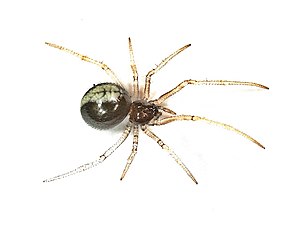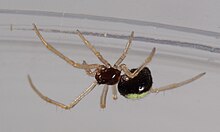White ribbon nest guardian
| White ribbon nest guardian | ||||||||||||
|---|---|---|---|---|---|---|---|---|---|---|---|---|

White-banded nest keeper ( Neottiura bimaculata ), female |
||||||||||||
| Systematics | ||||||||||||
|
||||||||||||
| Scientific name | ||||||||||||
| Neottiura bimaculata | ||||||||||||
| ( Linnaeus , 1767) |
The white-banded nest guardian or two -spotted ball spider ( Neottiura bimaculata ) is a spider from the family of the canopy- web spiders (Theridiidae). The common names of the Holarctic species stem from the visual appearance and breeding behavior of the female.
features
The body length of the female of the white ribbon nest guardian is 2.1 to 3.1 millimeters and that of the male 2.3 to 2.5 millimeters. The species is quite long-legged in relation to the body and thus reminds of a canopy spider (Linyphiidae). The colors can sometimes be very variable. Like other spider species, the white-banded nest guardian has a very pronounced sexual dimorphism (difference between the sexes).
female
The larger female has a much more contrasting color scheme than her male counterpart. The carapace (back shield of the prosoma or front body) is light yellowish to reddish brown in color and usually shows a broad and dark longitudinal stripe. The sternum (breast plate of the prosoma) is light brown with a dark edge or occasionally evenly dark in color. The sternum also has an elevation in the middle. The legs are light yellow to yellow-brown.
The opisthosoma (abdomen) is spherical in the female and has a brown to dark brown basic color. On the dorsal side there is a whitish to yellowish median band of varying dimensions. Thus, only the flanks of the opisthosoma can be darkly colored or the darker coloring can be completely missing. In this case, the abdomen has a bright, reticulated pattern or the median band consists of bright spots that run vertically. The ventral side of the opisthosoma is dark brown in the female, with sometimes a light spot behind the epigyne (female sex organ). The epigyne is also strongly prominent.
male
The smaller male appears uniformly darker than the female. The prosoma here has a red-brown basic color. The carapace of the male is raised in a conical shape in the eye area and the sternum in the center is arched outwards. The legs appear light yellow to yellow-brown, as in the female. The pedipalps (transformed extremities) are comparatively long and the bulbi (male genital organs) are of quite large shape and black in color. The Cymbii (organs of introduction of the Bulbi) are pointed.
In the male, the opisthosoma (abdomen) is cylindrical in shape and colored from brown to black. It is on some specimens with light spots or lines running down the center. Their number is usually two, which is where the scientific species name bimaculata (Latin for "two-point") and the common name "Zweifleckige Kugelspider" come from.
Similar species

The white-banded nest guardian, like all nest guardians ( Neottiura ), is reminiscent of the species of real ball spiders ( Theridion ) within the same family. Safe distinguishing features are u. A. the longer femora of the pedipalps and the larger cymbii and bulbi of the male nest keepers. In addition, the Cymbii are modified in the nest keepers and have z. B. lateral projections and protrude over the sclerite (hard parts of the chitin armor ) of the bulb. The prosoma and sternum of the real ball spiders are shorter than those of the nest keepers, in which the clypeus (head shield) is also shaped somewhat protruding. The legs of the nest keepers are longer and thinner than those of the real ball spiders.
Occurrence
The wide distribution area of the white ribbon nest guardian includes North America , Europe , Turkey , the Caucasus , Russia , Kazakhstan , Iran , Central Asia , China and Japan . Finds from North Africa are also known.
Habitat

The euryöke (tolerant of various environmental factors) and hygrophilous (moisture-loving) species live mainly in the edges of forests and roads, where they prefer low, herbaceous plants. Various open habitats and light forests are also taken.
Threat and protection
The white ribbon nest guardian is common in many places. It is classified in the Red List of Threatened Species of Animals, Plants and Fungi in Germany as "safe" and is therefore not subject to any protection status in Germany . The IUCN does not count the global population of the white ribbon nest guardian .
Way of life

Like many other species of bonnet spiders, the white-ribbon nest keeper creates an irregular spider web typical of this family for the purpose of catching prey. Other arthropods fall into the prey spectrum . It lays the safety net both on the ground in low vegetation and on the underside of oak leaves , where the white-banded nest guardian can often be found together with the dwarf ball spider ( Paidiscura pallens ).
Phenology
Adult males of the white ribbon nest guardian can be found between April to September and adult females from May to October.
Reproduction

While the female usually does not leave its safety net, the male usually runs around freely looking for nets from sexual partners. Some time after mating, the female lays one or two egg cocoons and attaches them to her safety net. Females with cocoons can be found between June and July. The behavior of the female is striking in the event of disturbances, for example when encounters with predators (predators). In such a case the female attaches the egg sacs such as in wolf spiders (Lycosidae) to the spinnerets attached, supported and moved to a safe place. This behavior, which is present in all nest keepers ( Neottiura ), has given the genus its trivial name.
Systematics
The white ribbon nest guardian received more changes and renaming. First describer Carl von Linné classified the species in the first description in 1767 like all species of the genus Aranea and gave it the name A. bimaculata . The name Neottiura bimaculata , which is common today , was first used in 1868 by Franz Anton Menge and has been used consistently since 2001, following an application by Hajime Yoshida . Before that, it was often used together with the names Theridion brachiatum ( Thorell , 1856) and Theridion bimaculata ( Simon , 1894) as a name for the species.
The white ribbon nest guardian is the type of nest guardian ( Neottiura ) today and, due to the increased renaming, nowadays has other synonyms besides those already mentioned. These are.
- Aranea carolina Walckenaer , 1802
- Theridion carolinum Walckenaer , 1805
- Theridion dorsiger Hahn , 1831
- Linyphia bimaculata C. L. Koch , 1835
- Theridion reticulatum C. L. Koch , 1845
- Steatoda reticulata C. L. Koch , 1850
- Linyphia dorsigum Siemaschko , 1861
- Theridion lepidum Becker , 1896 (probably actually for the swamp glass ball spider ( Rugathodes unabilis ))
- Theridion nivarium Saito , 1959
gallery
Excerpt from Monographia Aranearum = monograph of the spiders by Carl Wilhelm Hahn (1820)
Individual evidence
- ↑ a b c d e f g h i j k l m n Neottiura bimaculata (Linnaeus, 1767) from araneae Spiders of Europe, by Wolfgang Nentwig, Theo Blick, Robert Bosmans, Daniel Gloor, Ambros Hänggi & Christian Kropf, accessed on 30 March 2020.
- ↑ a b c d e f g h i j Heiko Bellmann: The cosmos spider leader. Over 400 species in Europe. Kosmos Naturführer, Kosmos (Franckh-Kosmos), 2nd edition, 2016, p. 84, ISBN 978-3-440-14895-2 .
- ↑ a b c d e f g h i j k l m n o p q r s Neottiura bimaculata (Linnaeus, 1767) from Natur in NRW, accessed on March 30, 2020.
- ↑ a b c d e f Neottiura bimaculata (Linnaeus, 1767) from Nature Walk, accessed on March 30, 2020.
- ^ B. Knoflach: The comb-footed spider genera Neottiura and Coleosoma in Europe (Araneae, Theridiidae). Mitt. Switzerland. Entomol. Ges. 72, 1999, pp. 341-371.
- ↑ a b c Neottiura bimaculata (Linnaeus, 1767) in the WSC World Spider Catalog , accessed March 30, 2020.
- ↑ Neottiura bimaculata (Linnaeus, 1767) in the Red List Center, accessed on 30 March 2020th
- ↑ Neottiura bimaculata (Linnaeus, 1767) in Global Biodiversity Information Facility , accessed on 30 March 2020th
literature
- Heiko Bellmann: The cosmos spider guide. Over 400 species in Europe. Kosmos Naturführer, Kosmos (Franckh-Kosmos), 2nd edition, 2016, ISBN 978-3-440-14895-2 .
- B. Knoflach: The comb-footed spider genera Neottiura and Coleosoma in Europe (Araneae, Theridiidae). Mitt. Switzerland. Entomol. Ges. 72, 1999, pp. 341-371.
Web links
- White ribbon nest guardian in the World Spider Catalog
- Neottiura bimaculata (Linnaeus, 1767) at Global Biodiversity Information Facility
- Neottiura bimaculata (Linnaeus, 1767) in Fauna Europaea
- Neottiura bimaculata (Linnaeus, 1767) at the Red List Center
- Neottiura bimaculata (Linnaeus, 1767) in araneae Spiders of Europe, by Wolfgang Nentwig, Theo Blick, Robert Bosmans, Daniel Gloor, Ambros Hänggi & Christian Kropf
- Neottiura bimaculata (Linnaeus, 1767) in nature in NRW
- Neottiura bimaculata (Linnaeus, 1767) on a nature walk








